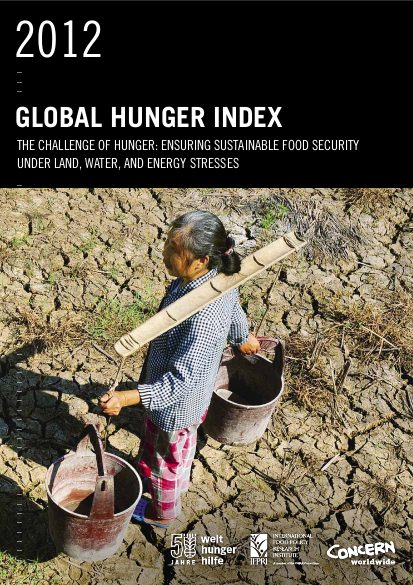
World hunger, according to the 2012 Global Hunger Index (GHI), has declined somewhat since 1990 but remains “serious.” The global average masks dramatic differences among regions and countries. Regionally, the highest GHI scores are in South Asia and Sub-Saharan Africa. South Asia reduced its GHI score significantly between 1990 and 1996—mainly by reducing the share of underweight children— but could not maintain this rapid progress. Though Sub-Saharan Africa made less progress than South Asia in the 1990s, it has caught up since the turn of the millennium, with its 2012 GHI score falling below that of South Asia. From the 1990 GHI to the 2012 GHI, 15 countries reduced their scores by 50 percent or more. In terms of absolute progress, between the 1990 GHI and the 2012 GHI, Angola, Bangladesh, Ethiopia, Malawi, Nicaragua, Niger, and Vietnam saw the largest improvements in their scores. Twenty countries still have levels of hunger that are “extremely alarming” or “alarming.” Most of the countries with alarming GHI scores are in Sub-Saharan Africa and South Asia (the 2012 GHI does not, however, reflect the recent crisis in the Horn of Africa, which intensified in 2011, or the uncertain food situation in the Sahel). Two of the three countries with extremely alarming 2012 GHI scores—Burundi and Eritrea—are in Sub-Saharan Africa; the third country with an extremely alarming score is Haiti. Its GHI score fell by about one quarter from 1990 to 2001, but most of this improvement was reversed in subsequent years. The devastating January 2010 earthquake, although not yet fully captured by the 2012 GHI because of insufficient availability of recent data, pushed Haiti back into the category of “extremely alarming.” In contrast to recent years, the Democratic Republic of Congo is not listed as “extremely alarming,” because insufficient data are available to calculate the country’s GHI score. Current and reliable data are urgently needed to appraise the situation in the country. Recent developments in the land, water, and energy sectors have been wake-up calls for global food security: the stark reality is that the world needs to produce more food with fewer resources, while eliminating wasteful practices and policies. Demographic changes, income increases, climate change, and poor policies and institutions are driving natural resource scarcity in ways that threaten food production and the environment on which it depends. Food security is now inextricably linked to developments in the water, energy, and land sectors. Rising energy prices affect farmers’ costs for fuel and fertilizer, increase demand for biofuel crops relative to food crops, and raise the price of water use. Agriculture already occurs within a context of land scarcity in terms of both quantity and quality: the world’s best arable land is already under cultivation, and unsustainable agricultural practices have led to significant land degradation. The scarcity of farmland coupled with shortsighted bioenergy policies has led to major foreign Summary investments in land in a number of developing countries, putting local people’s land rights at risk. In addition, water is scarce and likely to become scarcer with climate change. To halt this trend, more holistic strategies are needed for dealing with land, water, energy, and food, and they are needed soon. To manage natural resources sustainably, it is important to secure land and water rights; phase out inefficient subsidies on water, energy, and fertilizers; and create a macroeconomic environment that promotes efficient use of natural resources. It is important to scale up technical solutions, particularly those that conserve natural resources and foster more efficient and effective use of land, energy, and water along the value chain. It is also crucial to tame the drivers of natural resource scarcity by, for example, addressing demographic change, women’s access to education, and reproductive health; raising incomes and lowering inequality; and mitigating and adapting to climate change through agriculture. Food security under land, water, and energy stress poses daunting challenges. The policy steps described in this report show how we can meet these challenges in a sustainable and affordable way.
